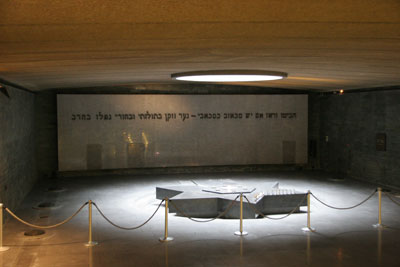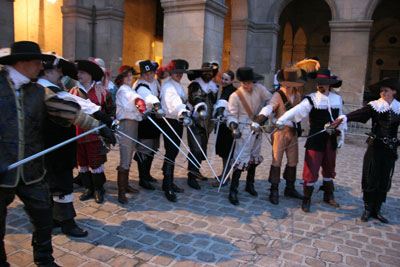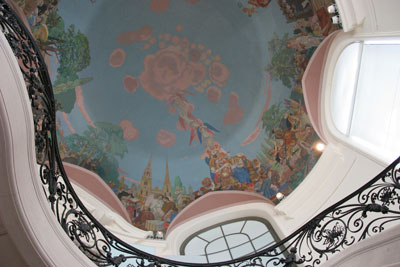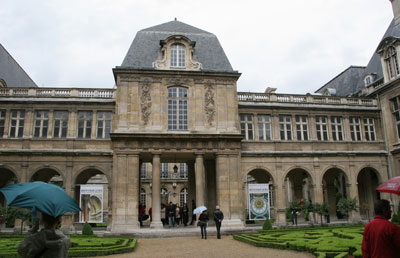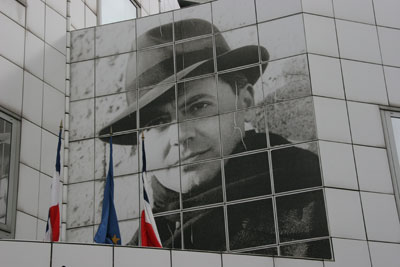Pinching pennies in Paris
by Paula Prindle, Orient, OH
On our most recent trip to Paris, in May ’09, my husband, David, and I decided to put to the test all the articles we had read about free things to do in the city. We had never found Paris to be particularly easy on the wallet, and on this trip we were really pinching pennies.
Making arrangements
We started our planning by booking our airline tickets with frequent-flyer miles. These can’t be counted as free tickets, since there were charges, taxes and fees amounting to several hundred dollars, but it was cheaper than buying the tickets outright.
Instead of using the required 60,000 Delta SkyMiles each, we upped it to 80,000 and went over in Business Class Elite, returning in economy. This turned out to be an excellent choice; we arrived in France in much better shape after the comfortable night flight.
We stayed with friends for part of our two-week trip to France, and we rented an apartment for our four nights in Paris. Although many rentals are priced by the week, ours was available at a daily rate. With fewer people traveling in 2009 (or so they say), we were able to get the apartment for less than the asking price by waiting for confirmation until two days before our arrival in Paris. (Just in case, we had reserved a room in a hotel with a 24-hour cancellation policy.)
By renting an apartment, we had more personal space, we saved on meals and we felt more “French” by shopping for our provisions alongside locals doing the same. As a bonus, we saved on calories by making our own dinners rather than dining out on the rich French fare. Other bonuses at our apartment — a washing machine and unlimited phone calls, even to the USA!
For transportation in Paris we relied on the RATP, taking buses or the Métro everywhere. Together we used three carnets (groups of 10 tickets), each costing €11.40 ($17), during our four-day stay.
An evening of art
We were fortunate that the day we arrived in Paris was the Nuit des Musées, the one day of the year that most museums in France are free all evening. This occurs each year on a Saturday in mid-May; 2009 was the fifth year of this event.
Many of the museums mark the evening with something special — guest speakers, concerts, candlelight visits or tastings — and most of them are open from 7 p.m. until midnight or later.
We began our Night of the Museums at the Palais de Chaillot, situated across the Seine from the Eiffel Tower. I have always loved its Musée des Monuments Français, which was closed during our last visit to Paris. Reopened in September ’07, this museum is now part of the Cité de l’Architecture et du Patrimoine.
We spent our time on the ground floor “traveling” around France, marveling at the scale models of famous French landmarks and the life-size architectural elements made by taking molds of the actual Romanesque, Gothic and Renaissance tympanums, columns, gargoyles, arches, chapels and more.
The details are easier to see here than on the originals because they are closer to eye level, and the copies are so exact that you can read the graffiti on them!
Since we had other museums we wanted to visit that night, we did not wait for the special (and, reportedly, very popular) candlelight tour of the second-floor mural and stained-glass gallery, but the medieval chants drifting down to us almost made us rethink our plans.
Anyone with a penchant for French architecture will enjoy this museum. The normal entrance fee is €8 ($12) per person.
From there we hopped on the No. 63 bus to get to the Musée de l’Armée at Les Invalides. The line to get inside the museum was long and slow-moving, but our interest was caught by the action taking place in the courtyard.
We found ourselves mixing with dashing Musketeers, 18th-century aristocrats with powdered faces and wigs, Madame Defarge look-alikes and Napoleonic-era duelists. The king’s army was also there, drilling, marching and thrusting to the delight of the crowd.
Normal entry fee for the museum is €8.50.
After the costumed hoopla at Les Invalides, we dazedly walked right past the Hôtel Biron, home of the Musée Rodin, which was supposed to be our next stop. I am not terribly fond of the statues inside the museum, but the ones in the garden are magnificent. We didn’t mind missing it that night, though, since entry to the garden is always a bargain at €1.
The walk to the Musée de l’Orangerie was damp; luckily, we had umbrellas. Since this museum’s reopening after its recent renovation, it is always crowded, but I thought if we visited it last, the crowd might have thinned a little. Not so! There had to be 400 to 500 people in line, all hoping to see Monet’s “Water Lilies.”
The line didn’t appear to be moving, so we contented ourselves with the great views of the Place de la Concorde and the Champs-Élysées by night. Giving up a museum or two didn’t bother us much when we had the sparkling Eiffel Tower and illuminated Paris as substitutes.
Memorial and more museums
We awoke on Sunday ready to begin our “free Paris” excursions. First on our list was the Marais district, which offered several free venues. The Holocaust Memorial (Mémorial de la SHOAH) was very moving and is very detailed. You could easily spend a half day there. I had to drag David away.
The museum displays original deportation records of the 76,000-plus Jews transported from France during WWII as well as countless photos and excellent films. A stark shrine holds victims’ ashes.
The memorial is open every day except Saturdays and Jewish holidays. There is a thorough security search at the entrance.
A visit to the Musée Cognacq-Jay, housed in one of the lovely 16th-century hôtels (private mansions) of the Marais, is a delightful step into the past. The collection of Théodore-Ernest Cognacq and his wife, Marie-Louise Jay, founders of La Samaritaine department store, is displayed in four floors of rooms decorated in the styles of Louis XV and Louis XVI. The emphasis is on 18th-century art, including paintings by Boucher, Canaletto, Fragonard, Tiepolo and Watteau. The museum is closed Mondays.
We did not do justice to the Musée Carnavalet, a museum on the history of Paris. This museum deserves at least a half day, maybe a full day. Since it’s free, why not do the pre-Revolution section before lunch and the Revolutionary period afterward?
As much as I admire and respect Rick Steves (and I do!), I disagree with his low opinion of the first half of the museum. We found the pre-Revolution section fascinating. After all, the history of Paris did not begin in 1789.
The museum consists of two mansions connected by a corridor. Mme de Sévigné, the “court reporter” of happenings at Louis XIV’s Versailles, lived in one of the mansions.
Wear your most comfortable shoes for a visit here. The museum is closed Mondays.
When not on museum overload, try to see the Musée Victor Hugo in the Place des Vosges. We found it a bit of a letdown after the others we had seen that day.
Be advised that you need a ticket to get in. The tickets are free, but you must obtain one from the gift shop before venturing into the museum.
The ground floor has a short film in French on the life of Victor Hugo. The museum is closed Mondays.
Walking tour and more
As noted, many of Paris’ free museums are closed on Mondays. So what to do on that day of the week? How about joining a free walking tour of Paris with Sandemans New Europe (Berlin, Germany; phone +49 30 510 50030)?
Beginning at the Place Saint-Michel fountain in the Latin Quarter at 11 a.m. and 1 and 4 p.m., these tours are absolutely free; the guides work for tips. If you don’t like the tour, don’t tip, but I can honestly say that our entire group was very pleased.
Our guide was Colin, a young Englishman with a good sense of humor and an excellent grasp of French history. The French teacher in me was skeptical at the start, but Colin was so knowledgeable and such an interesting tale-weaver that he kept us all riveted. He is easily one of the best guides we’ve ever had.
We had a short lunch/rest break about halfway through the tour and ended at the Petit Palais four hours after we started. I don’t think any of us were even tired!
Sandemans offers similar tours in Berlin, Munich, Hamburg, Brussels, London, Edinburgh, Amsterdam, Dublin, Madrid, Prague, Jerusalem and Tel Aviv.
The following day we visited the Petit Palais, built for the 1900 World’s Fair. It is a majestic building, the architecture at least as interesting as the artwork housed within. The circular staircase in the rear (on the Seine side) is topped by a dome covered with the painting “The History of French Art” by Maurice Denis, which depicts artists and their most famous works.
If a guard stops you here and says free entry is forbidden as this is part of a temporary exhibit requiring a ticket, try telling him you will not go up the staircase and you just want to view the ceiling of the dome (la Coupole Dutuit).
Just off the Champs-Élysées, this museum (closed Mondays) is a peaceful respite from the crowds. If nothing else, be sure to visit its quiet interior garden. There is also a nice café that looks out on the garden, plus some of the best restrooms in Paris.
A look at WWII
Our final free destination in Paris was a building housing two WWII museums, built alongside the park atop the Montparnasse train station.
The Jean Moulin Museum and the Memorial to Marshal Leclerc & the Liberation of Paris were opened in 1994 for the 50th anniversary of the liberation of Paris. Leclerc led the Free French forces that liberated Paris on Aug. 25, 1944, and Jean Moulin was the unifier of the French Resistance.
Together the museums present detailed pictures of France during WWII, Vichy France, Paris under the German Occupation, France’s Resistance from 1940 to 1944 and the Resistance in Paris.
The site of the museums is important; inside the railroad station below, General von Choltitz, the head of the German army in Paris who defied Hitler’s order to destroy the city, signed the cease-fire agreement ordering the surrender of the city to the Allies.
Although both museums are small, they are well organized and loaded with fascinating information often overlooked in larger museums. Plan to spend at least an hour in each museum; you can relax in the rooftop garden in between. Closed Mondays.
Declaring success
We found that Paris passed the test; the City of Light can be easy on the wallet. Paris is loaded with free museums, walks and other activities. We did not begin to scratch the surface, but we did our best!
This webpage has a handy list of free venues, but any Yahoo or Google search should turn up plenty more. Most guidebooks also list free venues.
Sometimes you learn about freebies by word of mouth. For example, our walking tour guide, Colin, mentioned a free Notre Dame tour. According to the official website, these visits, in English, are scheduled from 2 to 3:30 on Wednesdays and Thursdays and from 2:30 to 4 on Saturdays. Check the online calendar to confirm the schedule.
Paris also has plenty of inexpensive hotels and restaurants; you just have to look. When we aren’t renting an apartment, we like to stay at the Lux Hôtel Picpus (74 boulevard de Picpus) on the east side of Paris, near Place de la Nation. Although not in the center of the city, it is quiet and comfortable. Large (for Paris) doubles cost €59 per night, and the well-stocked buffet breakfast is a bargain at €8.
Check out reviews on Trip Advisor.
The Nation area has many cafés and brasseries for inexpensive dining.
There is no need to spend a lot for meals in Paris, even in the city center. Colin took us to one of the Aux Pains Perdus, a chain of soup/salad/sandwich shops, for lunch, and the food was very good. It would be difficult to spend over €10 there for a big salad or sandwich plus dessert and a beverage.
We stopped at the one on rue de l’Echelle, just off rue de Rivoli, half a block from the Louvre. It’s easy to find — it’s across the street from McDonald’s.
Don’t stay home because you’re afraid of “expensive” cities. Paris is indeed a feast. Help yourself!


